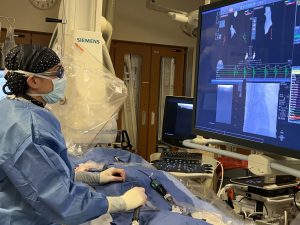Wolf Parkinson White Syndrome (WPW)
 Wolf Parkinson White syndrome or WTW is an arrhythmia of the heart that causes a fast heartbeat. It is considered a supra ventricular tachycardia or SVT. As we have discussed elsewhere on this website, the electrical signal of the heart begins in the left atrium at the SA node. The electrical signal travels down through the AV node between the atria and the ventricles and stimulates the ventricles to contract for a coordinated, regular heartbeat. Patients who have WPW have an extra pathway to the ventricles known as an accessory pathway. This extra pathway can result in the electrical signal passing too fast to the ventricles or allowing the electrical signal to return to the atria.
Wolf Parkinson White syndrome or WTW is an arrhythmia of the heart that causes a fast heartbeat. It is considered a supra ventricular tachycardia or SVT. As we have discussed elsewhere on this website, the electrical signal of the heart begins in the left atrium at the SA node. The electrical signal travels down through the AV node between the atria and the ventricles and stimulates the ventricles to contract for a coordinated, regular heartbeat. Patients who have WPW have an extra pathway to the ventricles known as an accessory pathway. This extra pathway can result in the electrical signal passing too fast to the ventricles or allowing the electrical signal to return to the atria.
As a result of WPW, the heart can move very quickly as the errant electrical signals create additional heartbeats. About 50% of patients suffering from WPW have reentry of the electrical signal. While WPW and its symptoms are separate from atrial fibrillation, the two conditions can coexist. The greatest concern for patients with WPW is that it creates a condition known as ventricular fibrillation – where the ventricles start beating in an uncontrolled manner, which can be life-threatening.
Causes of WPW
WPW is present at birth, meeting that it is a congenital condition. It occurs more often in men than women and men have a higher chance of having multiple accessory pathways. Overall, WTW is not common, occurring in about .1-.3% of the population. There may also be a genetic component to WPW.
Symptoms of WPW
In some patients, like other arrhythmias, WPW presents no symptoms at all. However, symptoms, when they do occur, may include many of the effects that patients with other super ventricular tachycardias may experience including:
- Pounding in the chest or the feeling of a racing heart
- Dizziness and fainting
- Shortness of breath and inability to perform normal activities
- Fluttering in the chest
- The possibility of cardiac arrest also known as sudden cardiac death
How We Diagnose WPW
The tools that we used to diagnose WPW include an EKG, Holter monitor, event monitor, and/or loop recorder. Each of these is used in specific ways for patients that would best benefit from their unique features. Much like other cardiac arrhythmias, an electrophysiologist is best suited to make the appropriate diagnosis and create the treatment plan.
How We Treat WPW
Depending on the severity of symptoms, treatment may or may not be necessary. For patients without symptoms, we may opt for watchful waiting to see how symptoms progress. In fact, some of these accessory pathways may even disappear over time.
Medications are also an early option, but many patients cannot tolerate the side effects associated with these medications. Most people with WPW are candidates for a cardiac catheter ablation or cryoablation which destroys the accessory pathway(s) using targeted heat or cold therapy.
For more information about the diagnosis and treatment of WPW or if you’re experiencing any of the symptoms associated with an arrhythmia, please contact our office for a consultation so we can properly evaluate your situation and recommend a treatment plan.